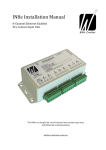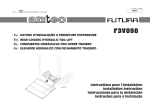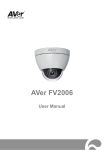Download ELVi-4e Installation Manual
Transcript
ELVi-4e Installation Manual 4-Channel Ethernet Controlled Industrial Grade ELV Relay The ELVi-4e is a simple industrial grade 4-channel ELV (Extra Low Voltage) relay, controlled via Ethernet whitecreations.com.au White Creations Industrial ELV Relay Range ELVi-4s ELVi-4e ELVi-8s ELVi-8e 4 channel RS-232 controlled ELV Relay 4 channel Ethernet controlled ELV Relay 8 channel RS-232 controlled ELV Relay 8 channel Ethernet controlled ELV Relay Disclaimer & Conditions of Use: White Creations ELV Relay products are not intended for use where there may be any risk to persons or property. White Creations will not be held liable for any injury or damage to property caused by our products. You must use White Creations products only in non-crucial (or “convenience”) elements of a system - where a failure may inconvenience the user, but not directly or indirectly cause damage to any property or injury to any persons. Do Not Open Device! No User Serviceable Parts inside. Opening the device for any reason will void any warranties. For technical support or product faults please contact whitecreations.com.au/techsupport This manual is subject to change without notice; the latest version is available at whitecreations.com.au/manuals 2 Contents Industrial ELV Relay Features 4 ELVi-4e Specifications 5 Hardware Installation 6 Testing Hardware Installation 6 Ethernet Configuration 8 TCP/IP Connections 14 TCP/IP Protocol 14 Remote Control and Port Forwarding 16 Contact White Creations General Enquiry: Technical Support: Place an order: Product Manuals: whitecreations.com.au/enquiry whitecreations.com.au/techsupport whitecreations.com.au/order whitecreations.com.au/manuals 3 Industrial ELV Relay Features Our Industrial Grade ELV Relay has been developed with the installer in mind. We have tried to make it really easy for installers to install, and programmers to integrate with. We have also tried to provide this at the lowest possible price. For Installers: Quality pluggable screw terminal connectors - easy to install, replace, debug, and fault-find Local toggle mode for easy debugging and fault-finding LED indicators for status of each relay Normally Open, Normally Closed, and Common terminals for each relay Rugged Industrial Grade metal construction, designed to operate in harsh environments with high temperatures For Programmers: Easy ASCII string to control relays Simple ‘No Frills’ control - discretely set each relay ON or OFF Easily configure Ethernet models by connecting to it through a web browser For Everyone: Well priced Very reliable Great Australian support Why So Cheap? We have sacrificed some convenience measures to lower the cost as much as possible. We hope you agree that the low cost outweighs any inconvenience. Not supplied with a power supply - Multiple units can operate from a single 12V power supply, so instead of providing one with each unit, you can install them as needed - You may already have a 12V power supply installed for other equipment that you could use to power this relay - If you do need to install a power supply, you may be able to get one cheaper than what we could supply Local toggle uses 1 button (test mode) - On other products you might see a toggle button for each relay. To reduce costs for you we have only got 1 button. You press the button to toggle the first relay channel, and hold it down to cycle through which relay channel to control. We acknowledge that it’s not that straight forward, so we have printed the instructions for this “test mode” on the front of the device. No fancy packaging - We’ve packaged the device so that it can be safely shipped, but that’s about all. 4 ELVi-4e Specifications Relay channels: 4 Relay terminals: NO, NC, COM Control: Ethernet TCP/IP Default IP Address: 192.168.1.222 Default port: 10001 Max Ambient Temp: 70⁰C Relay output rating: 30V, 5A Operating Voltage: 12V DC Operating Current: 350mA max Physical Dimensions: 111mm x 82mm x 40mm ELVi-4e Top View Test Button Power LED Ethernet 12V DC Input - 12V DC negative + 12V DC positive Channel Status LEDs NO-C-NC NO-C-NC Channel 1 Channel 2 NO-C-NC NO-C-NC Channel 3 Channel 4 Relay Contact Terminals Channel 1-4 NO: Normally Open Contact C: Relay Contact Common NC: Normally Closed Contact Hardware Interfaces: Test Button: Use a paperclip to press the Test Button though the small hole in the ELVi-4e case while rebooting to enter Test Mode (See Testing Hardware Installation) Power LED: In Normal Mode, the Power LED is ON with a quick blink off when a command is received. In Test Mode, it will flash Ethernet: RJ45 connection to Ethernet network 12V DC Input: DC power input terminals Channel Status LEDs: Indicate the current status of each relay channel Relay Contact Terminals: Dry contact relay output terminals – NO, C, NC connection for each relay, rated at 30V AC or DC, 5A 5 Hardware Installation 1. Mount ELVi-4e firmly in a dry indoor climate 2. Wire relay terminals to desired control devices 3. Wire power supply and connect device to Ethernet network Tip: If using the ELVi-4e to restart equipment, it is recommended to use the NC relay contact. That way it will always allow power at start-up and when there are no commands (ie the relay defaults to the OFF position, and when using the NC terminals that will allow power through). To restart the equipment send an ON command (which opens the NC terminal and will disconnect power), wait a while, then send an OFF command (which closes the NC terminal and will reconnect power). This is recommended because the ELVi-4e uses less power and runs cooler when relays are not energised. Testing Hardware Installation There are two modes you can boot into: Test Mode and Normal Mode You can easily test your installation by booting into Test Mode. This will allow you to manually toggle relay channels, even if the ELVi-4e is not configured or connected to an Ethernet network. Normal Mode is used for normal operation. The ELVi-4e will always default to Normal Mode. To boot to Normal Mode: Simply power up without the test button pushed. The ELVi-4e will also return to Normal Mode after 2 minutes of inactivity in Test Mode. Using Normal Mode: While in normal mode, all Ethernet commands are processed, and the Test Button is ignored. The Power LED will be on solid, with a quick blink off when it receives a command. To boot to Test Mode: 1. 2. 3. 4. 6 De-power ELVi-4e Use a paper clip to press and hold the Test Button Power up unit while continuing to hold the Test Button 2 seconds after the ELVi-4e powers up, release the Test Button. The device is now in Test Mode. The Test Mode sequence will run, turning each relay channel on and then off in turn. The Power LED will then start blinking to indicate that it is in Test Mode Using Test Mode: You can press the Test Button in one of two ways: A “quick-press” means you press and release the button within 0.5 seconds A “long-press” means you press and hold the button for at least 1 full second and then release. Once the ELVi-4e boots into Test Mode, a quick-press of the Test Button will now toggle relay channel 1. You may quick-press as many times as you like to keep toggling channel 1. A long-press will set the button to control channel 2. Quick-presses will now toggle relay 2. You can long-press to cycle through all relay channels. A long-press while controlling channel 4 will return control to channel 1, where the cycle repeats. The ELVi4e will automatically exit Test Mode after 2 minutes of Test Button inactivity. While in Test Mode, Ethernet commands are ignored. To exit Test Mode, power cycle the ELVi-4e without the Test Button pushed, or wait 2 minutes. Quick Reference Table - Normal and Test Modes Normal Mode Test Mode How to exit Power up without the Test Button pushed Boot to Test Mode Power LED On Power up with the Test Button pushed Boot to Normal Mode or wait 2 minutes Flashing Ethernet control Controls relay channels Ignored Test Button Ignored Short-press: toggles selected relay channel Long-press: cycles through which relay to control How to boot to 7 Ethernet Configuration The Ethernet settings of the ELVi-4e are configured by its configuration web page. There are 2 ways to connect to the ELVi-4e for the first time. Below is a quick overview of the 2 methods, and there are detailed procedures on the following pages. Methods for connecting to the ELVi-4e for the first time: Method 1: Connect via Ethernet Network If your PC is on a network in the range 192.168.1.xxx and there is no device at 192.168.1.222, then you can plug the ELVi-4e into the network, and open its configuration web page by typing its IP address into a web browser. If your PC network is not in that range, you will first have to connect via Direct Connect, and change the IP configuration of the ELVi-4e to be in the range of your network Method 2: Connect via Direct Connect You can directly connect by plugging the ELVi-4e directly to your PC with a crossover Ethernet cable. You will need to assign a static IP address to your computer in the 192.168.1.xxx range, and then you can open the ELVi-4e configuration web page by typing its IP address into a web browser Once your PC is on the same network and in the same IP range as the ELVi-4e, you can access the ELVi-4e configuration web page (see Configuring the ELVi-4e), or you can start controlling relay channels by connecting to it with a terminal program and sending it control strings (see TCP/IP Protocol). 8 Method 1: Connecting to the ELVi-4e for the first time via Ethernet Network 1. Check if your PC is on a network in the IP range 192.168.1.xxx Click Start >> Control Panel >> Network and Sharing Center Click “Details” Workstation Shows this window Click “Wireless Network Connection” Check that your settings are: IP address is 192.168.1.xxx Subnet mask is 255.255.255.0 Default gateway is 192.168.1.xxx 2. If your PC is in the 192.168.1.xxx range, then proceed to the next step. If not then you may have to connect and configure the ELVi-4e using the Direct Connect method. You could then change the network configuration of the ELVi-4e to be in the same IP range as your Ethernet network and then you can connect to it this way 3. Check that there is no network device present at 192.168.1.222 a. Click Start, type “cmd” and hit enter b. In the command prompt, type “ping 192.168.1.222” and hit enter c. The response will tell you if this IP address is in use. (if the response is “Reply from 192.168.1.222…” then there is a device at that IP address, if the response is “Request timed out” or “Reply from < other IP address>”, then the IP address is free 4. Disconnect any device at 192.168.1.222 if present, then plug the ELVi-4e into the network 5. You can now connect to the ELVi-4e. You can configure settings by typing its IP address into a web browser (see Configuring The ELVi-4e), or you can start controlling relay channels by connecting to it with a terminal program and sending it control strings (see TCP/IP Protocol) Tip: Using smartphone apps like Fing make it really easy to scan the IP addresses on your network 9 Method 2: Connecting to the ELVi-4e for the first time via Direct Connect 1. Disconnect your PC from any hardwired or wireless networks 2. Use a crossover Ethernet cable to connect the ELVi-4e to your PC Ethernet port, then power up the ELVi-4e. (note: on modern PC’s a straight through cable may also work) 3. Set your PC’s IP address to static and give it an IP address Click Start >> Control Panel >> Network and Sharing Center Workstation Shows this window Click “Properties” Click “Local Area Connection” Select “Use the following IP address” then fill out these details Shows this window Select “Internet Protocol Version 4” Then click “Properties” When done, Click “OK” for both Windows 4. You can now connect to the ELVi-4e. You can configure settings by typing its IP address into a web browser (see Configuring The ELVi-4e), or you can start controlling relay channels by connecting to it with a terminal program and sending it control strings (see TCP/IP Protocol) 10 Note: to re-connect to your existing wired or wireless network, you need to restore your PCs IP settings back to what they were, usually you would have to follow the same procedure as above, but select “Obtain IP address automatically” and “Obtain DNS server address automatically” Configuring the ELVi-4e Once your PC is on the same network as the ELVi-4e and in the same IP range, you can access the ELVi-4e configuration web page to change the network settings. Open your web browser (internet explorer, safari, etc) and type in the ELVi-4e IP address into the browser address bar (default IP address is 192.168.1.222). When prompted, enter the user name “admin” and the password and click “Log In” (the default password is <blank> ). You now have the ELVi-4e web configuration page, which appears like this. (The Ethernet processor of the ELVi-4e is based on the Lantronix XPort chipset, hence their branding on the web page). The home page shows an overview of the current network settings, while the left hand pane navigates through all the pages of settings of the ELVi-4e. 11 Configuration Settings The following pages are available containing configuration settings: Home – Shows an overview of current network settings Network – Contains user-configurable network settings (DHCP/Static, IP Address, etc) Server – Contains user-configurable web server settings (web configuration password, etc.) Serial Tunnel - Hostlist – Advanced use only – for specifying host devices for the ELVi-4e to initiate a connection to Channel 1 - Serial Settings: Contains factory-configured settings. Do not change any of these settings as it will cause the ELVi-4e to malfunction. If you do accidentally change these settings, you should hit “Apply Defaults” to restore them to factory configuration. Please note that this will reset any other changes you have made - Connection: advanced use only – network communication settings (TCP/UDP, Client/Server, port number, etc.) Email – Future use, please contact us if you’re interested Configurable Pins – Future use, please contact us if you’re interested Apply Settings – Once you’ve changed settings on a page, you need to hit “OK” at the bottom of the page, then “Apply Settings” to save and reboot. This will disconnect any current TCP/IP connections Apply Defaults – Sets all settings back to factory defaults, except IP Address which changes to DHCP Common Configuration Settings The most common way to use the ELVi-4e is as a TCP server, which means it continually waits for an incoming connection. A TCP client will then connect to it, send control strings, and disconnect as needed. To run in this configuration you can either use the default settings (no configuration necessary), or configure these settings: Set ELVi-4e to DHCP or Static, set IP address, subnet mask, Default Gateway, DNS Server. Using a static IP address is recommended - In “Network” page (See Network Settings Parameter Descriptions –next page ) Set a password for the ELVi-4e configuration web pages - In the “Server” page (See Server Settings Parameter Descriptions –next page) Advanced Configuration Settings Advanced configuration settings are available but shouldn’t be changed unless there is a specific reason to change them. This manual does not go into details for advanced settings. If you have an installation where advanced configuration is required, please contact White Creations for the advanced user manual. 12 Network Settings Parameter Descriptions IP Configuration: - Obtain IP Address Automatically: When enabled, you can change the Auto Configuration Methods, and DHCP Host Name. Note: If you need to change the Auto Configuration Method settings do not disable all 3 methods, as the only method will then be ARP (default is all enabled, leaving them all enabled is recommended) - Use the following IP configuration: When enabled, you can specify a static IP address, Subnet Mask, Default Gateway, and DNS Server. Enter these parameters in decimal-dot notation. The IP Address must be set to a unique value on the network Ethernet Configuration: - Auto Negotiate: For advanced users only, please leave this option enabled unless you have a specific reason to change it Server Settings Parameter Descriptions Server Configuration: - Enhanced Password: When enabled you can create a password up to 16 characters in length, when disabled you will be limited to 4 characters - Telnet/Web Manager Password: This is the ELVi-4e configuration web page access password. Choose a password you will not forget as there is no external reset – the only way to factory default the ELVi-4e without the web manager password is to send it back to White Creations, in South Australia - Retype Password: Retype the Telnet/Web Manager password above to confirm Advanced: For advanced users only, please leave at default values unless you have a specific reason to change them Saving Changes Once you’ve changed settings on a page, you need to hit “OK” at the bottom of the page, then “Apply Settings” to save and reboot. This will disconnect any current TCP/IP connections. Please do not change any settings unless you understand what they do. If you need some support please contact White Creations Technical Support: whitecreations.com.au/techsupport 13 TCP/IP Connections To control the ELVi-4e relay channels, you can connect to it via its IP address and port number, and send it the appropriate control string. There are many devices capable of sending TCP/IP strings to Ethernet devices like the ELVi-4e including: Automation and Control Systems (eg. Crestron, AMX, C-Bus, push control4, etc) Smartphone apps (eg. Command Fusion iViewer, TCP/IP remote, etc) A PC running a TCP/IP terminal program (eg. Realterm) Default Network Settings IP Address: 192.168.1.222 Subnet Mask: 255.255.255.0 Default Gateway: 192.168.1.1 DNS Server: 192.168.1.1 Control Port: 10001 Web Port: 80 TCP/IP Protocol You may send a 5-byte TCP/IP string to the ELVi-4e to turn on or off the relay channels. There must be an 80ms or greater delay between command strings. The command sting consists of 5 ASCII characters, and is in this format: R Relay Channel Number C ASCII Character Capital “R” Relay Channel Number. Valid Values are 1-4 ASCII Character Capital “C” 14 On or Off Command <CR> Carriage Return ASCII Character “ n ” = On, “ f ” = OFF Command Table The following shows all available commands you can send to an ELVi-4e relay unit. Note that <CR> represents the ASCII character for a carriage return (hex 0D) Available Commands Relay Channel 1 On Relay Channel 1 Off Relay Channel 2 On Relay Channel 2 Off Relay Channel 3 On Relay Channel 3 Off Relay Channel 4 On Relay Channel 4 Off All Relay Channels On All Relay Channels Off Get Status Of All Relay Channels String to send to device RC1n<CR> RC1f<CR> RC2n<CR> RC2f<CR> RC3n<CR> RC3f<CR> RC4n<CR> RC4f<CR> RCan<CR> RCaf<CR> RCgs<CR> Response from the ELVi-4e Once a valid command string has been received by the ELVi-4e, it will respond indicating which channel was last set. If the device does not recognize a string, it may return the string “Invalid command”. Examples To turn on relay channel 1 of the ELVi-4e, send the string: RC1n<CR> The ELVi-4e will respond with: Channel 1 is On<CR> To turn off relay channel 3 of the ELVi-4e, send the string: RC3f<CR> The ELVi-4e will respond with: Channel 3 is Off<CR> To get the status of all relay channels of the ELVi-4e, send the string: RCgs<CR> The ELVi-4e will respond with the current state of each relay channel, in the format: Channel 1 is Off<CR> Channel 2 is Off<CR> Channel 3 is On<CR> Channel 4 is On<CR> 15 Remote Control and Port Forwarding The ELVi-4e can be controlled remotely by setting up port forwarding in the remote site’s internet router. The IT department can open an external port to point to the internal IP address and port of the ELVi-4e. You can then connect to the ELVi-4e through the internet from another location, using the external IP address of the site and the external port assigned to you. Port 80 must be forwarded for access to the configuration web page, and port 10001 must be forwarded to control relay channels. Note: Port 80 and 10001 are the default ports used by the ELVi-4e. If you can’t communicate on these ports, the installer may have changed them. For domestic applications, most decent internet routers will allow port forwarding, but you may need to set up a dyndns (or similar) account to keep track of your external IP address. This manual does not go into specific details as each router is different. You should ‘google’ your router model to find information to set this up. If you need some support, please contact White Creations Technical Support: whitecreations.com.au/techsupport. General Enquiry: Technical Support: Place an order: Product Manuals: 16 whitecreations.com.au/enquiry whitecreations.com.au/techsupport whitecreations.com.au/order whitecreations.com.au/manuals

























